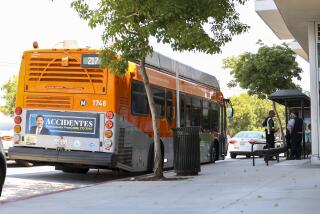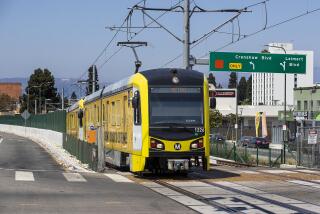Valley Transit Study Is Given One More Year
- Share via
Keeping pressure on the MTA to reform bus service in the San Fernando Valley, a group studying creation of a breakaway bus system got a one-year extension Tuesday. The Los Angeles City Council and county Board of Supervisors gave the group, scheduled to disband Dec. 31, more time to explore the feasibility of a bus system that would break away from the Metropolitan Transportation Authority.
The council also authorized the Valley Transit Zone study group to look at a proposal by the MTA aimed at heading off an autonomous Valley bus system.
Under that proposal, the MTA would divide its service area into four or five sectors, each with its own headquarters, general manager and budget, but still under the MTA’s authority.
Council President Alex Padilla said the MTA has proposed to begin its sector program in the Valley on July 1.
“We hope they keep their word,” said Padilla, who is vice chairman of the study group. But by continuing to study an independent system, “we are letting them [MTA] know we are serious about this, that if they don’t follow through on the sector proposal that we are going to move forward.”
He said he and other Valley leaders who have been working to create a Valley bus system probably would be willing to drop the effort if the MTA sector plan works.
John Catoe, deputy chief executive of the MTA, called the council’s action “a very positive step” that implicitly recognizes the sector plan as a possible alternative.
“It’s a demonstration that the council as well as staff listened to us and realized that we’re not coming up with a fantasy. We’ve thought this out,” Catoe said.
The proposed sectors would serve the San Fernando Valley, the San Gabriel Valley, the Central/Westside area, and south of downtown. Each would make its own decisions on bus routes and schedules. The agency is considering further splitting the southern area, with the South Bay as a fifth sector.
The MTA hopes to roll out its sector programs countywide by the end of 2002. The agency is expected to present a more detailed plan to the Joint Powers Authority board early next year.
The idea “has promise,” said county Supervisor Zev Yaroslavsky, who heads the Joint Powers Authority. “We are still waiting for the details.”
“We’re not abandoning the zone idea” of an autonomous Valley bus system. “But if the sector approach by the MTA is equal or better than the zone, we’re all ears,” Yaroslavsky said. “We want Valley control over transportation. We don’t have that now.”
Members of the study group say they expect this to be the last time an extension of their authority will be needed, because they hope to decide on a Valley transportation plan next year.
In related action, the council voted unanimously Tuesday to designate the northeast Valley as the priority location for a north-south bus route planned by the MTA with $100 million in state funds.
Several north-south routes have been proposed, including one by Councilman Hal Bernson along Canoga Avenue in the West Valley linking the Chatsworth Metrolink station with Warner Center.
Amid concern that a dispute could lead the MTA to delay any north-south project, the council went on record Tuesday as supporting a route in the northeast Valley, which might include Lankershim, Van Nuys and Sepulveda boulevards.
The council action, backed by Bernson, says any money left after the northeast Valley is served can be used to develop other north-south systems.
The council took the action after Assembly Speaker Bob Hertzberg (D-Sherman Oaks) weighed in with concern.
“Although I harbor no strong objection to studying additional routes in the west San Fernando Valley, I believe the ridership numbers and demographics make a compelling case for siting a transit corridor in the northeast Valley,” Hertzberg wrote in a letter to the council.
More to Read
Sign up for Essential California
The most important California stories and recommendations in your inbox every morning.
You may occasionally receive promotional content from the Los Angeles Times.











